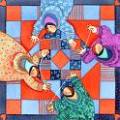
Quilting Reviews
|
Patchwork Techniques
Patchwork Techniques
When many people hear the word quilt they think of many colorful blocks or patches created from old clothes sewn together to form a large rectangular blanket. Pieced patchwork is actual much, much more complicated. Pieced patchwork is made from fabric scraps that are cut into regular shapes and then sewn together in geometric patterns to form blocks. The pieces may be joined by hand or machine. Machine stitching is quicker and more durable but hand stitching is traditional.
Creating an accurate template will allow a quilter to make patches identical in shape and size, and that will fit perfectly together. Templates may be made or purchased. To make a cardboard template transfer the design on to squared paper and cut it out with sharp scissors. Glue the cutout to a piece of cardboard. Be sure to include a seam allowance. Cut out the cardboard template and protect the paper seam allowance by coating it with a thin layer of clear nail varnish or polish. Always make new templates for each shape required in a project.
To make a plastic template, place the clear plastic over the design and draw around each shape. Draw a seam allowance around each shape and cut out.
Once you have created a template, place it on the fabric, lining up one straight edge with the grain of the fabric. Draw around it with a quilter's pencil or tailor's chalk. To create several patches at once fold the fabric in several layers-accordion style. Staple the template to the layers and cut out the pieces, preferably using a rotary cutter and a cutting mat.
If you are using backing papers or iron on interfacing they may be attached now.
To join the patches and form the patchwork, first lay them out and make sure you are happy with the design. Once you are, you may begin piecing. Hand piecing requires the patches to be placed right sides together and pinned. Pin each corner first. Join each patch with a small whipstitch, inserting the needle in one corner and working across to the other. Remove the pins as you go.
If you are machine piecing your patchwork, you may join several pairs of patches at a time by using the flag method. Pin the patches right sides together in pairs. Machine stitch along the seam line using the foot as a guide. Leave s short uncut thread between the pairs. Cut each into units. Join enough pairs to make one patched piece. Remember to press the patch seems flat to one side to avoid bulk. Do not press them open.
Once you patchwork quilt top has been completed, layer it together with batting in the middle and backing fabric on the back. Baste the layers and quilt as desired. If you are quilting straight lines and using a machine, a quilting foot made for this purpose is available. For free-form quilting remove the foot completely and lower the foot lever. Use your hands or a hoop to stretch the fabric taut, and stitch slowly.
 |
 |
 |
How To Choose The Right Batting
How To Use Templates In Quilting
Add Life To Your Quilting With Embroidery
More Quilting Articles
... colors like blues, greens or violets, will make them look more vivid. Combining fabrics with various print scales and styles can add visual texture to your quilt. Interesting visual effects may also be achieved by using colors of graduated values. Printed cotton fabrics are available in many designs and ...
... cotton, silk, or synthetics. It is used in appliqu . Silk is fabric that is woven from natural fibers produced by silk worms. It works well for almost any project and is available in a variety of textures, colors, patterns and weights. Shantung fabric is woven from yarns of irregular thickness giving ...
How To Use Templates In Quilting
... be used over and over again, templates make marking and cutting pieces for a quilt block a breeze. Templates generally have seam line and other markings on them for the convenience of quilters. The best templates are laser cut to ensure exact precision for measurement. With quilting templates, a rotary ...
The Best Quilting Pattern ForYour Needs
... of decades. This is a boon for the quilting enthusiast, because it has resulted in a huge number of patterns that are now available. Even a brief look around the internet or your local bookstore will prove to you that it's a confusing world when it comes to buying a quilting pattern. The new quilter may ...

|
| Copyright © 2006-2012 Internet Marketing Tools, All Rights Reserved |